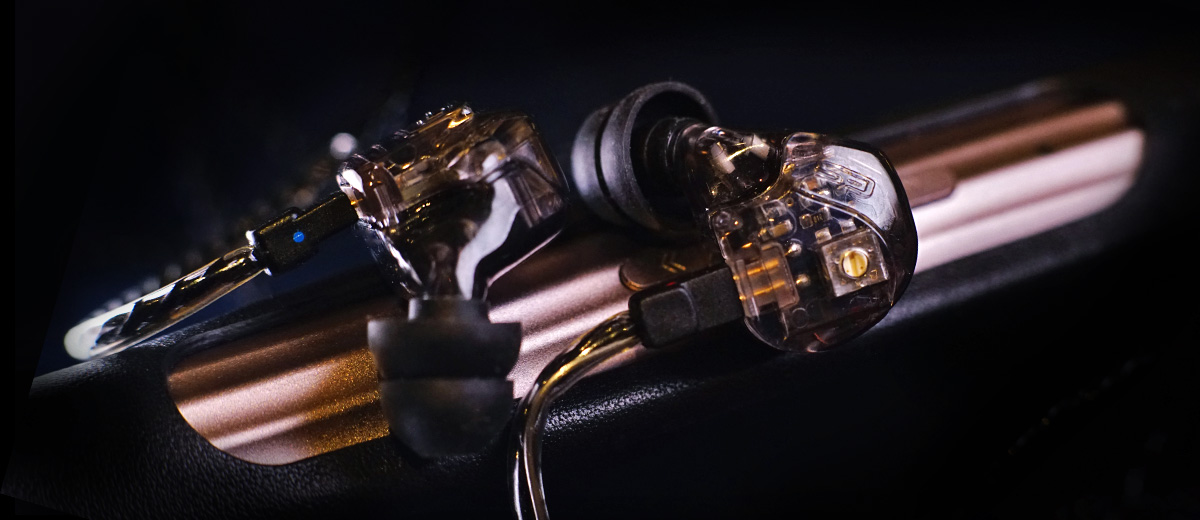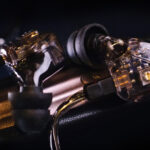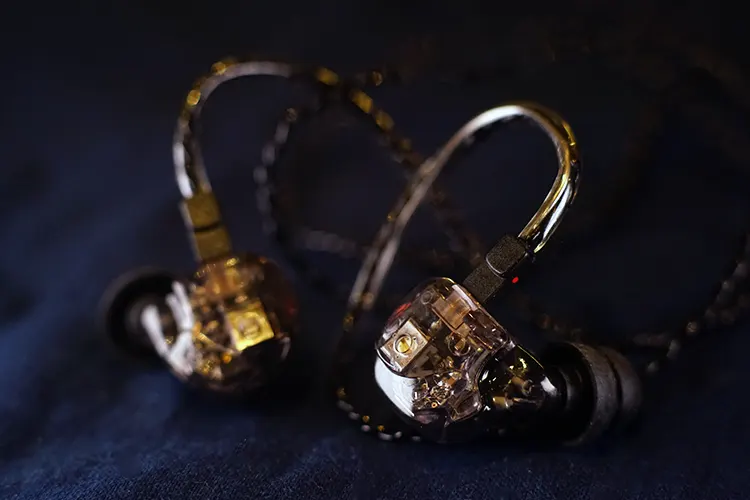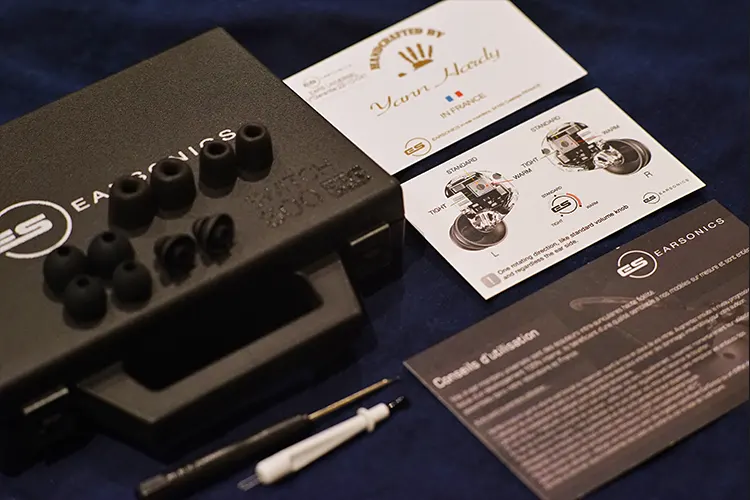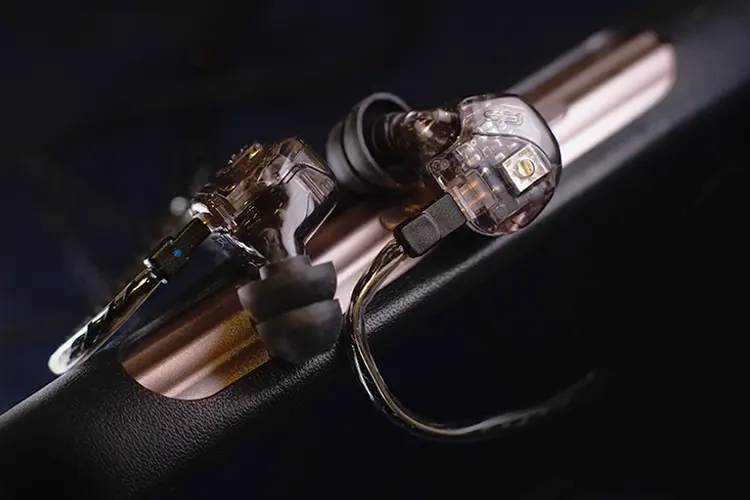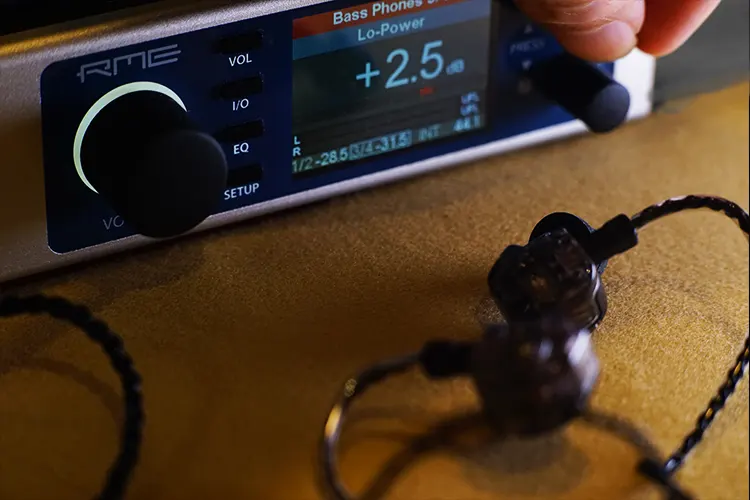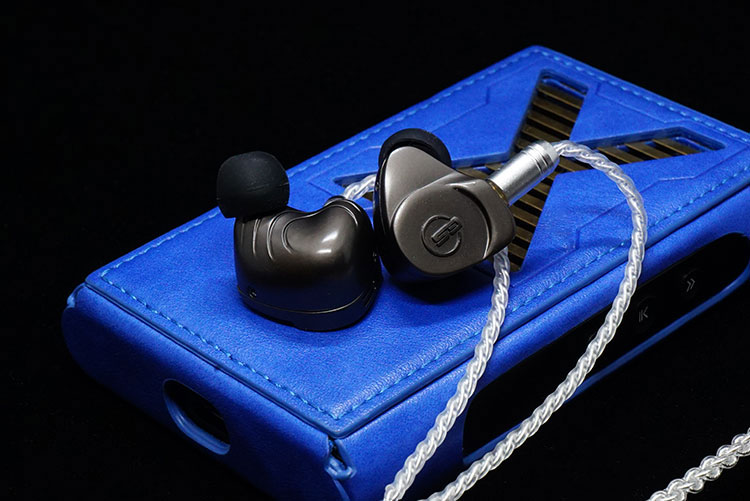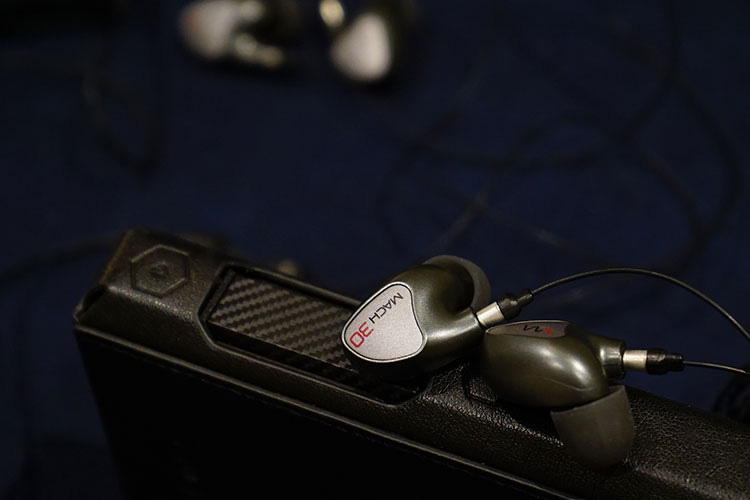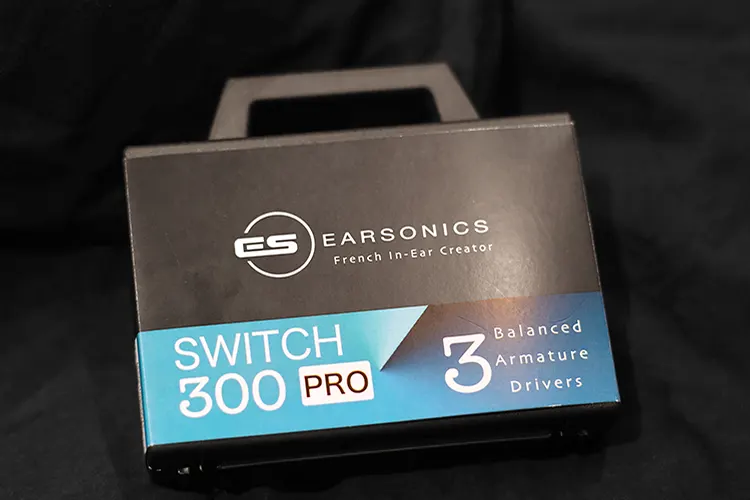Today, we review the Earsonics SWITCH 300 PRO, which is a triple balanced armature driver in-ear monitor equipped with 3 unique sound modes. It is priced at €599.
Disclaimer: This was sent to us as a sample for our honest opinion. Headfonics is an independent website with no affiliate links or services. We thank the team at Earsonics for giving us this opportunity.
To learn more about the Earsonics products we have previously discussed on Headfonics click here.
Note, that this article follows our latest scoring guidelines which you can read here.
We have previously covered Earsonics’ audiophile line products such as the ONYX and CORSA, but this time we are taking a look at the French brand’s new PRO series.
The SWITCH 300 PRO is a triple BA IEM that also comes with a tuning switch to give you a choice of sound signatures.
The earphones offer a light profile and versatile self-tuning design, making them stand out from the metallic models targeting the consumer market. However, how do they compare to the competition? Let’s dive in and find out!
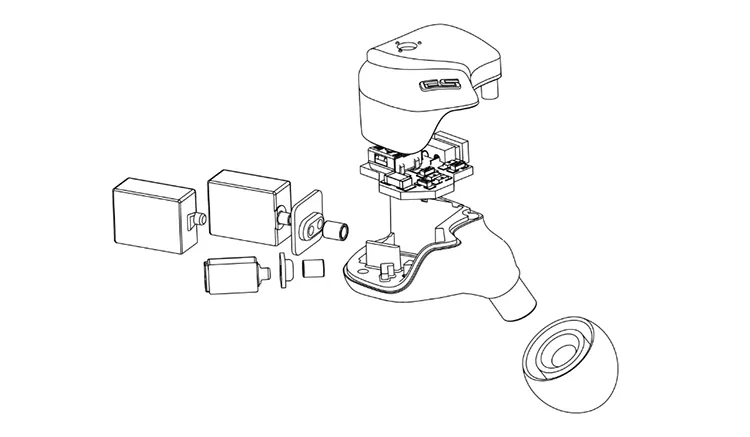
Tech Highlights
The Earsonics SWITCH 300 PRO is a universal in-ear monitor equipped with three transducers per side. The drivers are connected via Earsonics’ 3-way HQ crossover with impedance correctors.
Moreover, the earphones integrate an electronic board that provides three distinct filtering options, which are adjustable via the switch located on the front side.
You get 3 distinct tuning modes, namely “Tight”, “Standard”, and “Warm”. Upon testing, the “Tight” and “Warm” filters appeared to be delicate low-cut and high-cut filters, respectively.
This feature enables professional users to switch effortlessly between different sound modes and concentrate on specific frequencies, such as boosting the lower frequencies for bass players.
It is worth noting that there is also a non-switch version but it lacks the adaptability to different music genres and sound preferences that the SWITCH 300 PRO provides, making it less exciting.
Design
The Earsonics SWITCH 300 PRO earphones boast distinctive aesthetics, thanks to their translucent injection-molded housing. While still drawing inspiration from metallic housing designs, this unique feature allows the user to view the PCB with crossover components and access the switch on the faceplate for tuning with the use of a small screwdriver.
This transparent housing not only adds to the earphones’ visual appeal but also provides a practical advantage by enabling users to access the tuning options and view the internal components easily.
Additionally, the transparent housing makes it simple to clean out the nozzles, ensuring optimal output quality over time. The earphones employ a 2-pin design, which enables users to easily swap to other aftermarket cables.
Comfort & Isolation
The Earsonics SWITCH 300 PRO earphones prioritize both style and functionality and boast a sleek profile with a tilted insertion angle that provides a secure fit in the ear, and also excellent passive noise isolation. The size of the IEM is quite small albeit big drivers can be seen through the shell, and you can get it to fit well at ease.
The length of the nozzle, paired with double flanges, enables deeper insertion compared to most common IEMs, further enhancing the earphones’ passive noise isolation capabilities. This allows musicians to listen to music clearly while playing instruments, even on stage.
Tips
The SWITCH 300 PRO earphones come with a comprehensive set of accessories, including three pairs of flanges in S/M/L sizes, two pairs of double flanges in S/M sizes, and a pair of foams.
Regardless of the option chosen, the earphones provide excellent seal and isolation. Out of the tips provided the foams offer the best isolation and bass performance.
The nozzle diameter of the SWITCH 300 PRO fits a variety of aftermarket tips, and it is recommended to experiment with different tips to find the best seal for optimal overall performance. With the inclusion of multiple tip options, the SWITCH 300 PRO earphones offer versatility and customization for individual preferences.
Stock Cable
The SWITCH 300 PRO comes with a stealthy, braided black cable that is very soft and sturdy. The cable is terminated in 2-pin and 3.5mm on the other end which is still a more common standard for professional use. Users can tie it at the back of the neck, and it doesn’t get tangled easily.
Packaging & Accessories
The Earsonics SWITCH 300 PRO are 100% made in France and are packaged in a suitcase-shaped container that also serves as a storage case.
In addition to the six sets of tips mentioned earlier, the package includes a screwdriver for adjusting the tuning switch on the earphones.
The overall packaging design is clean and professional. There is an instruction card for the tuning switch, as well as a card that showcases the artisans who handcrafted the earphones at Earsonics’ facility in France.
Sound Impressions
The SWITCH 300 PRO is a smooth and wide-sounding IEM that offers high versatility through its tuning mechanism. Unlike the consumer models the SWITCH 300 PRO does not try to elevate some frequencies to boost clarity and it maintains a more mellow, neutral output.
The vocals are also less rounded and sound naturally delivered. That said, the articulation is great and the stage rendered feels natural, wide, and effortless, especially with the “Tight” setting.
The default tuning on the Earsonics SWITCH 300 PRO earphones is the “Standard” setting, which is optimized for music genres that require a higher overall balance.
Additionally, it is also suitable for those who prefer a more neutral sound signature, without the midrange overpowering other frequencies. The other two modes, “Tight” and “Warm”, offer more distinct signatures.
The “Tight” tuning provides a cleaner and less thick lower end, resulting in greater detail in the upper register. This mode is particularly effective for lighter and cleaner instruments, allowing them to cut through the mix with greater power.
On the other hand, the “Warm” filter smoothens out the treble, reducing the sharpness and intensity of high-frequency sounds.
Putting it simply, turning to “Tight” trims down the bass and enhances overall clarity and vocal penetration power. “Standard” unveils the airiness powered by the big drivers, and the “Warm” mode goes by its name to deliver more body and fullness in the lows.
Bass
Testing using the RME ADI-2 PRO and my MacBook Pro the Bass on the SWITCH 300 PRO sounds pretty firm and accurate with a rather speedy attack and slightly soft decay.
The sub-bass hit moderately deep and isn’t shy on the “Standard” tuning, but if you are listening in a noisier environment or on stage, you could turn to “Warm” settings to bring forward the mid-bass frequencies and further enrich the bass line.
On “Warm” mode the output leans more to the lower bass such that bass guitar, drums, and other synthesized bass instrument gets more rumble and feels more full-bodied, but not too fat.
The vocals have a tad bit less bite though that may sweeten up some sharper voices. The effect is just right on point such that it doesn’t hamper the tonal balance while bringing more presence to the low end.
With a big-size bass driver the SWITCH 300 PRO sounds energetic and fairly detailed, it is able to capture the rumbles while being quite dynamic. Overall, it feels smooth and adequately textured.
Mids
The SWITCH 300 PRO sounds quite balanced on all three modes and the vocal isn’t positioned very close in positioning in all cases. Despite that, the swift articulation helps render a wide and deep stage and can handle well stronger, sharper voices and maintain a distinct stereo image and decent dynamics.
On the default “Standard” filter the mids sound uncompressed and moderately separated, there is enough energy also truthfulness in the upper bass for Pops and live to sound engaging, and the spacious presentation is capable of handling bright and full vocal works livelily.
The “Warm” filter option behaves like a high-cut that rounds off the treble and makes the output sweeter, by taking away the sparkles. This results in boosting the perceived thickness and body of the low-end frequencies which could give more presence to darker voices and bass instruments.
Treble
The treble is moderately textured with a tad bit of sharpness to color the output more accurately and excitingly. The intensity of the treble is quite balanced with the lower frequencies and so it helps shape a natural output and to sound smooth and soothing.
Except for live music recordings, the relaxing tuning works well when playing working BGMs, EDMs, and fast synthesized tunes.
Turning to the “Tight” setting, the bass gets trimmed down slightly and more of the treble details are revealed. This enhances the technical performance as the bass sounds faster and more treble transients are pushed forward.
It may get slightly more aggressive and would help the vocal overtones and drums to cut through easier, bringing about more clarity and a sharper, more defined image as well as stronger separation.
Staging
The soundstage is the biggest delight for this set and out of the box the SWITCH 300 PRO sounds expansive and natural, having instruments well spaced out. For a 3 BA, it sounds quite wide and since the vocal is slightly laid back, it feels deep on the Z axis.
All 3 filtering options sound quite wide and deep probably due to its non-intrusive mids tuning, and it leaves good room for different elements in the soundstage rendered to sound distinct and without altering their sound signature to boost clarity.
Synergy
Efficiency
The SWITCH 300 PRO is rated at 119 dB/mW sensitivity; and 31.5-41.5Ω impedance based on different filter settings. Just like the specs suggest the background is dark on my players and on the RME ADI-2 Pro, which helps strengthen the dynamic performance.
Pairings
Putting it on the RME ADI-2 Pro, there is a decent resolution, dynamics, and a very controlled bass. I use the internal equalizers to elevate the bass and the treble, and it is quite responsive without distorting or flattening the output.
Testing with portable players that have more warmth in the mid-bass area for example the Shanling M7, which is also a powerful device, the SWITCH 300 PRO punches firm in the sub lows and it kicks deeper than on the MacBook Pro. The vocal line is also strengthened to sound more energized and melodic.
With the HiBy R6 III, it sounds cooler on the default setting and the MSEB DSP options allow breathing more warmth into the mid-range at just a few clicks, which is quite a handy feature if you want to give the output more colors.
The SWITCH 300 PRO can sound quite loud and defined on a MacBook Pro or out of mid-end players yet there is room for it to scale with more proficient and powerful sources.
It sounds quite consistent on different to remain quite neutral in tone, probably due to its higher impedance rating and the tuning does not boost any particular frequency for clarity.
Select Comparisons
Earsonics CORSA
$400 EUR
Technical
The CORSA rated 31ohm in impedance and 119dB in sensitivity which is very close to the SWITCH 300 PRO’s specs. It also has a similar 1+1+1 design handling the lows, mids, and treble respectively.
Inside there is also an “Acrylic Heart” which is a framework that holds together the drivers, and everything is enclosed in a metal jacket. This is quite similar to the SWITCH 300 PRO, which also uses 3 drivers in a 3-way design, whereas there is an additional switch that allows the user to tune.
Design
The difference in aesthetics is very obvious in these two sets. The CORSA has a metallic build that feels more rigid, while the SWITCH 300 PRO is enclosed in an injected molded, plastic housing.
It seems nicer to have a metallic build over plastic though if you are using the IEMs for work and need to wear them for prolonged listening sessions, then the slimmer, lighter profile of the SWITCH 300 PRO would be much more suitable.
The two IEMS also come with different stock cables. The CORSA has a thicker cable which is responsible for some of its colorings in the output, while the SWITCH 300 PRO comes with a more professional and thinner cable optimized for stage or production use.
Performance
The Earsonics CORSA’s tuning somehow resembles how it looks, which is transparent and on the cooler side.
When comparing back-to-back the CORSA feels like the SWITCH 300 PRO turned towards the “Tight” filter, which leans more to the treble side, but the CORSA sounds more textured and sharper in the image with the upper vocal frequencies being more forwarded.
On CORSA the vocal intensity is stronger, and it sounds clearer, though the backing instruments are not as vividly captured compared to the SWITCH 300 PRO especially when it is turned to the “Warm” mode that gives bass instruments much more presence.
Despite not being as strong as the CORSA in terms of detail retrieval, with the more laid-back tuning the SWITCH 300 PRO renders a more balanced, relaxing stage and sounds more expansive than the CORSA.
The timbre of instruments, especially woodwinds which are livelier, and more details in the two ends of the frequency spectrum are extracted.
Westone Audio MACH 30
$499
Technical
The MACH 30 is another 3-way, 3 BA design that is rated at 91Ω @1kHz, 110dB in sensitivity, which seems a lot less sensitive to power than the SWITCH 300 PRO.
In practice, the SWITCH 300 PRO could be more easily driven by different gears to sound more textured and feel more dynamic, especially at a lower volume.
Design
Both MACH 30 and Switch Pro 300 are enclosed in non-metal housing and are equally compact. The MACH 30 has a more streamlined design while the Switch Pro 300’s clear housing allows users to peep inside, and also features a filtering function.
Both earphones are very light and come with a low-profile black cable that can be tied to the back of the neck stealthily and can be worn for hours without stressing the outer ear.
Performance
The MACH 30 is less sensitive to power, yet it is more mid-forwarded compared to the SWITCH 300 PRO and has a slight bump applied to the upper mids such that on less powerful devices it will still sound full and clear.
This allows the MACH 30 to sound more engaging with powerful but clinical-sounding gears, instruments are imaged closer, and you can feel bass drums impacting more upfront.
Putting both IEMs on the ADI RME-2 Pro and comparing the MACH 30 to SWITCH 300 PRO’s “Standard” tuning, the MACH 30 sounds fuller, more intimate, and rounded while the SWITCH 300 PRO sounds more expansive, truthful, and more swiftly articulated.
The mid-lows are not as prominent as heard on the MACH 30, therefore, more subtle details and rumbles in the sub-bass can be revealed, though the SWITCH 300 PRO sounds more natural, undampened, and unaltered in tone, as the upper mids are not as rounded compared to the MACH 30.
Our Verdict
The Earsonics SWITCH 300 PRO is quite different from the brand’s other metallic, consumer market-targeted earphones we have tested as it focuses on functionality and gives a more spacious, natural, and coherent presentation that matches the needs of professional users.
There is less altering to the output and does not push the listener to focus on particular frequencies, overly colors, or boost the resolution. If you are into mixing, playing on stage, or monitoring, the lightweight SWITCH 300 PRO would be a practical and versatile option.
Earsonics SWITCH 300 PRO Specifications
- Driver: 3 drivers, 3-way HQ crossover with impedance corrector
- Sensibility: 119 dB/mW
- Frequency response: 10 Hz -20 kHz
- Impedance: 31.5 to 41.5 Ω, (depending on the switch position)

